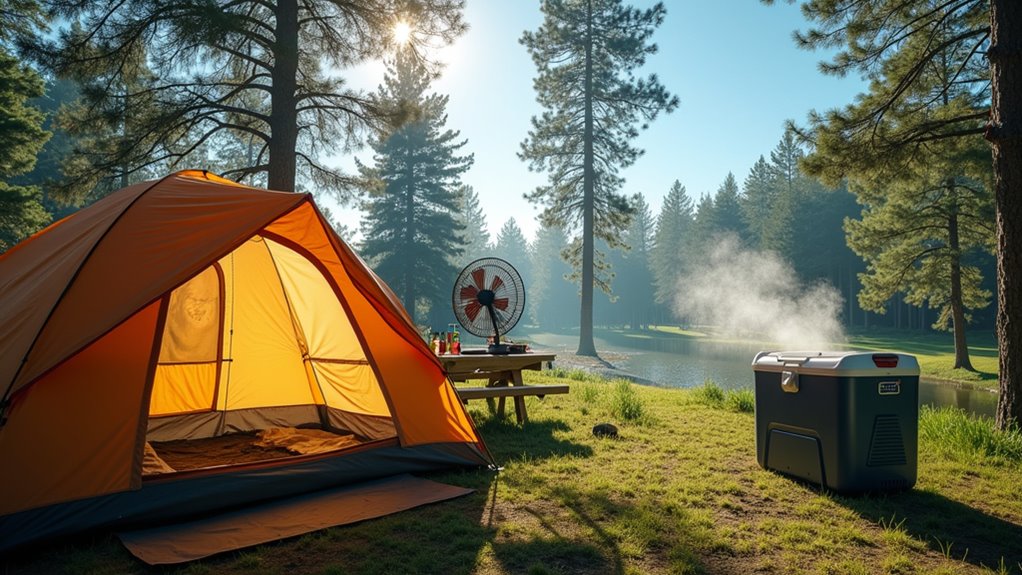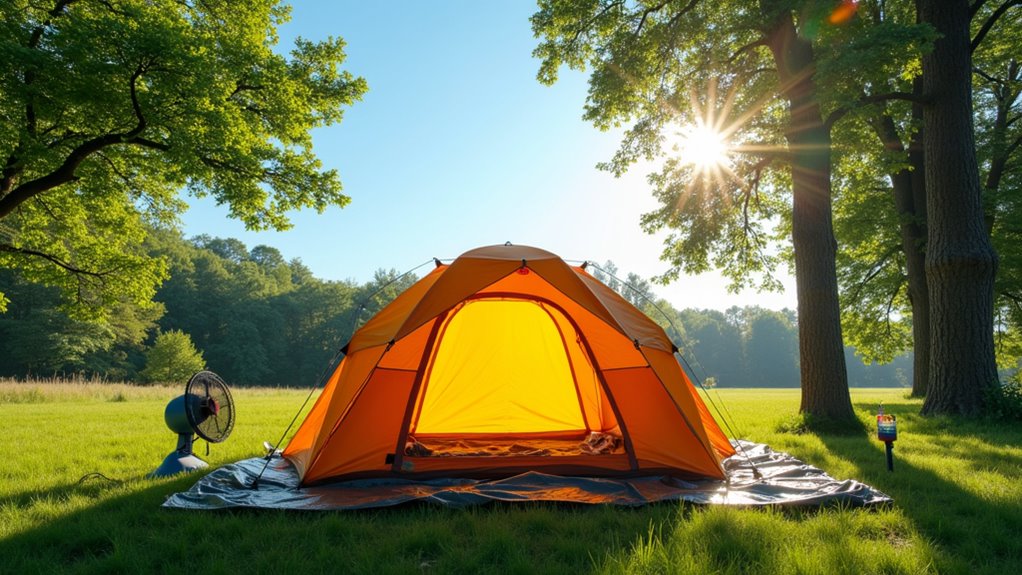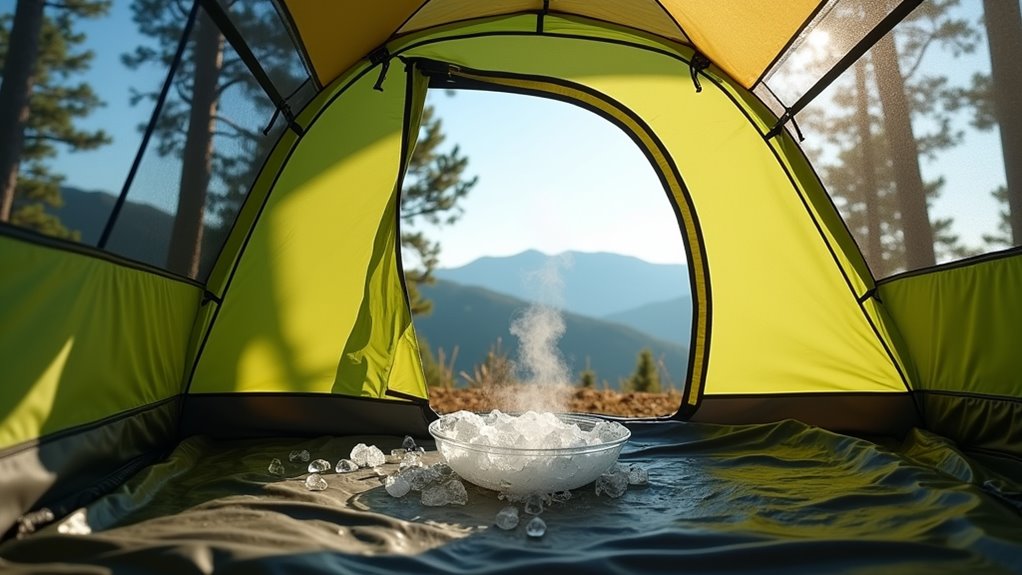How To Cool Down A Tent
This post contains affiliate links. As an Amazon Associate, we earn from qualifying purchases.
To cool down your tent effectively, use portable air conditioners such as the Waykar 4500 BTU or evaporative coolers that can lower temperatures by up to 20°F. Non-electric methods like setting up in shaded areas, creating cross-ventilation by opening all doors and windows, and hanging a wet towel at the entrance also help reduce heat. Choosing breathable, light-colored tents further improves airflow and comfort. Additionally, DIY solutions like cooler air conditioners with ice packs can provide relief. Further details and tips to ensure a comfortable camping experience are discussed below.
Essential Facts in 30 Seconds
- Pitch your tent in shaded or elevated areas to avoid direct sunlight and enhance airflow.
- Use portable air conditioners or evaporative coolers to lower tent temperature.
- Keep all doors and windows open for proper cross-ventilation.
- Hang a wet towel or sheet at the entrance to cool air via evaporation.
- Choose tents made of breathable, light-colored fabrics to reduce heat buildup.
Effective Cooling Devices for Tents

Cooling a tent is simple with the right devices. Portable air conditioners like the Cybertake S1 Pro deliver 3300 BTU cooling power. This suits tents about 130 square feet.
Larger tents need stronger units. The Waykar 4500 BTU air conditioner works well. It uses less power and runs quietly.
Evaporative coolers, such as the WayCool Portable Evaporative Cooler, lower air temperature by up to 20°F. They use water evaporation to cool the air. These coolers work best in dry, semi-arid areas. They cost only a few cents to run each day.
Oscillating fans inside these coolers spread air evenly. Think about your tent size, climate, and power options before buying. This ensures you stay cool and comfortable while camping.
Non-Electric Cooling Techniques
Cooling your tent without electricity works well with simple, natural tricks. Pick a campsite under trees or near rocks. Shade blocks the hot sun and cools the tent. Find a spot higher up to catch breezes. Air moves better there. Additionally, ensure that your tent has a good waterproof rating to help keep the interior dry and cool during hot weather.
Open all tent doors and windows. This lets air flow through the tent. Cross-ventilation pushes hot air out and brings cooler air in. Hang a wet towel or sheet at the tent entrance. Evaporation cools the air as it passes by. Keep the fabric wet to stay cool. You can also pitch your tent in shaded areas to further reduce heat.
Use reflective tarps over your tent. They bounce sunlight away and stop heat from building up. Sleep on a raised bed or mesh cot. Air flows under you, making you feel cooler.
Simple steps, big difference. Stay cool naturally.
| Technique | What It Does | Why It Helps |
|---|---|---|
| Natural Shade | Set up under trees or rocks | Blocks sun, lowers tent heat |
| Cross-Ventilation | Open doors and windows | Moves hot air out, fresh air in |
| Damp Fabric | Hang wet towel at entrance | Cools air with evaporation |
| Reflective Tarps | Cover tent with shiny tarp | Reflects sun, cuts heat |
| Elevated Sleeping Setup | Use a mesh cot or raised pad | Air circulates underneath |
Tent Material and Design Considerations

The right tent material and design make camping cooler and more comfortable. Use breathable fabrics like cotton canvas or silnylon. These fabrics help air flow and keep the tent from getting too hot inside. Choosing the right tent materials significantly affects your overall camping experience.
Light-colored tents reflect sunlight and lower heat. Some tents have special reflective coatings that block more heat. Silicone-coated fabrics last long and let some air pass through, which helps with heat control.
Avoid polyethylene (PE) coatings because they trap heat and moisture inside. Tents with mesh panels or vents let air move freely. Good ventilation stops the tent from feeling stuffy and hot. Tent cards are also a great way to communicate important information about your camping setup, enhancing overall experience and satisfaction.
These features work together to keep you cool during warm weather camping.
Passive Cooling and Site Selection
Selecting the right site for your tent helps keep it cool. Shade blocks up to 90% of the sun’s heat. Set your tent under thick tree branches or use tarps for shade. Wind cools the tent by moving hot air away. Place your tent where breezes flow, like near rivers or open spaces. Additionally, consider how to rainproof a tent to ensure that while you keep cool, you also remain dry in unexpected weather. Using a tarp under your tent can provide extra insulation against the cold ground, further enhancing your comfort during warm days and cool nights.
Check this guide:
| Site Selection Criteria | Benefits | Tips |
|---|---|---|
| Shaded Locations | Cuts solar heat by 90% | Use dense trees or tarps |
| Breezy Areas | Boosts airflow | Camp near water or open spots |
| Proper Orientation | Helps wind cool tent | Face tent entrance to wind |
Avoid low spots that trap warm air. Think about how the sun moves during the day. Shade works best when you plan for morning and afternoon sun. Good shade and wind together can drop your tent’s temperature a lot. That makes camping cooler and more comfortable.
Innovative DIY Cooling Solutions

Heat can make camping tough. DIY cooling tricks help your tent feel nice. Try these four smart ideas:
- Cooler Air Conditioner: Cut holes in a cooler. Add a fan and ice packs. Use PVC pipe to blow cool air inside.
- Wet Towel Trick: Hang a damp towel in the door. Air passes through and cools. A small fan helps air move faster.
- Tent Fans and Misters: Use small fans to move air around. A misting system sprays fine water for cool air. Ceiling fans work well too.
- Fans and Openings: Place fans in different spots to push air through. Big fans outside can blow hot air away.
These simple ideas keep your tent cool. Stay fresh and enjoy your camping!
Frequently Asked Questions
How Can I Prevent Condensation Inside My Tent?
Condensation forms inside tents because warm air meets cold surfaces. Open vents and doors to let fresh air flow. This lowers humidity and stops water drops from forming. Keep wet clothes and shoes outside the tent. Use a ground tarp to block moisture from the ground. These steps help keep your tent dry and comfortable. Dry air feels better and protects your gear from mold. Simple actions make camping more pleasant.
What Should I Do if My Cooling Devices Malfunction?
Cooling devices can stop working. Check if they have power. Clean the filters to help air flow better. Use battery fans to cool down quickly. Find shade to stay cooler too. Fix tents if air cannot pass through. Keep water nearby to stay safe in heat. Act fast to avoid heat problems.
Are There Specific Tents Designed for Extreme Heat?
Tents made for extreme heat do exist. They use special materials that resist heat well. These tents also have many vents to let air flow inside. Good airflow helps keep the tent cool. Some models even use reflective fabric to block sunlight. This makes camping in hot places much more comfortable. Choose tents with mesh windows and large doors for better air movement. These features help reduce heat inside the tent. Staying cool means a better night’s sleep outdoors.
How Do I Maintain My Tent Cooling Devices?
Keep your tent cooling devices in top shape by cleaning filters often. Check power cords for damage before each use. Fill water tanks to the right level every time. Store devices in a dry, cool place after use. Doing this helps your cooling tools work well and last longer. Stay cool and comfortable on every trip.
Can Pets Stay in a Cooled Tent Safely?
Pets stay safe in a cooled tent with the right care. Keep the tent well ventilated to avoid heat buildup. Check your pet often to see if they look comfortable. Make sure the tent stays calm and quiet to reduce stress. Use fans or cooling mats to help lower the temperature. Always provide fresh water nearby. Many pets handle cool tents well if you watch them closely. This simple care keeps pets happy and safe outdoors.
Conclusion
Tents often get very hot inside, sometimes 20°F hotter than outside air. Using a small fan helps move air and cool the tent. Shade lowers the temperature too. Setting up your tent under trees or near water can keep it cooler. Pick a tent with good ventilation. Open windows or vents to let hot air escape. Try DIY hacks like wet cloths or frozen bottles for extra coolness. Staying cool makes camping much better and more fun.
